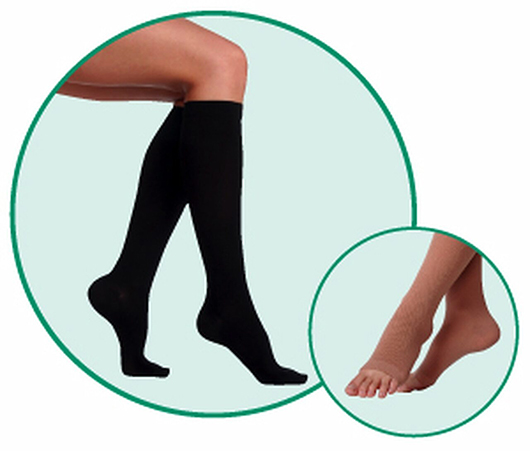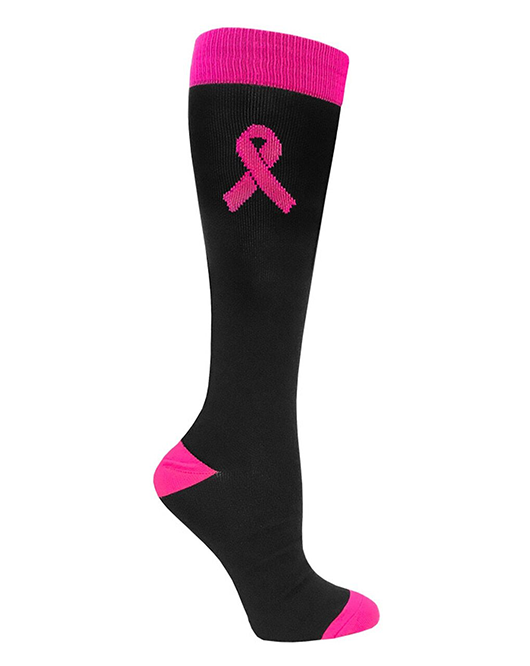Should Runners Wear Compression Socks?
Jan 5th, 2021
Running is one of the best forms of exercise, not only for weight management but also for overall health, including good blood circulation. Breast cancer survivors can also safely benefit from lacing up their running shoes and getting out on the track.
Once you’ve recovered after a lumpectomy, full or partial mastectomy, and you receive medical clearance, running can be one of the best exercises to get you back in shape and reduce the risks of cancer returning. Runners' compression socks are an excellent exercise to help you recover faster after a workout.
Many athletes swear by these socks for increasing performance, preventing injury, and enhancing post-run recovery. Even if you’re just starting or are training for your next marathon, here are a few things to consider before choosing whether to wear compression socks.
What are Compression Socks?
Compression socks are designed to look like your sports socks so that you can wear them discreetly with your workout gear. However, their unique design creates gentle pressure along your lower leg to encourage body fluids to return to the heart consistently.
While wearing compression socks, you can expect to feel slightly more pressure at the bottom, with a gradual lessening as you move upward toward your knee. Compression socks come in a variety of pressure levels, from light to extra firm. The ideal compression level for running is between 10-20 mmHg and labeled as mild.
However, to prevent or manage lymphedema, you may need a slightly higher compression level. Moderate compression socks ranging from 20-30 mmHg are perfect. Avoid using moderate or firm compression socks while running as they may inhibit blood flow rather than enhance it.
What are the Overall Benefits of Compression Socks for Runners?
Many women report that exercising, including running and jogging, is the ultimate way to provide the self-confidence they need to go forward with breast cancer treatments. By wearing compression socks while running, you can receive important health benefits.
Increases Blood Flow
Compression socks are designed to create graduated compression, with bottoms fitting slightly tighter and the tops becoming looser. Working against gravity, the compression funnels body fluids upward, increasing the flow to the heart.
Enhances Oxygen Delivery
When the deoxygenated blood makes its way back to your heart, the lungs get to work, adding the oxygen back in. As a result, that oxygen-rich blood is delivered to your muscles faster for optimal performance, even on long-distance runs.
Reduces Lactic Acid
Running, as with many other forms of exercise, produces lactic acid in the body. This waste product can lead to muscle soreness. The lactic acid is disbursed more quickly by wearing compression socks during or in the hours after running, keeping it from pooling anywhere and causing discomfort.
Lessons Lymph Fluid Build-Up
Breast cancer surgeries increase the risk of developing lymphedema. One way to prevent this is by wearing compression garments to increase a more natural lymph fluid movement.

Wearing knee-length compression socks or stockings during and also after running is an effective measure for preventing lymphedema. One type to consider is the Juzo Soft Stockings, made with a smooth knit for ease of wear and comfortability and a silicone beaded border to keep them in place while you run. They also come in two knee-high lengths, regular and short, and black and beige.
Reduces Muscle Swelling, Fatigue, and Leg Cramps
Runners report that compression socks reduced the incidence of swelling, leg muscle fatigue, and cramping while running and in the hours afterward. Recovery time is shortened, and athletic performance overall is enhanced so they can help energize you for your run and for the activities that follow.
What to Look for in the Best Compression Socks for Runners

While there are a few different compression socks available, look for the following when choosing the best compression knee-high socks for runners:
- Socks are designed with graduated pressure
- A comfortable fit without too much pressure in any one area and made of soft stretch material that doesn’t irritate your skin
- Smooth toe seam so as not to be uncomfortable while wearing your running shoes
- A non-binding top band
A Final Note
According to both athletes and casual runners, the health and performance benefits of wearing compression socks are numerous. These socks can also benefit breast cancer treatment survivors who take up running, including lowering the risk for developing lymphedema. However, talk with your medical professionals before purchasing compression socks to ensure you don’t have any health complications that could prohibit you from wearing them.
If you need help choosing the right compression socks, stockings, or other compression garments following your breast cancer treatment, contact one of our specialists here at Mastectomyshop.com by calling (877) 413-2272.



